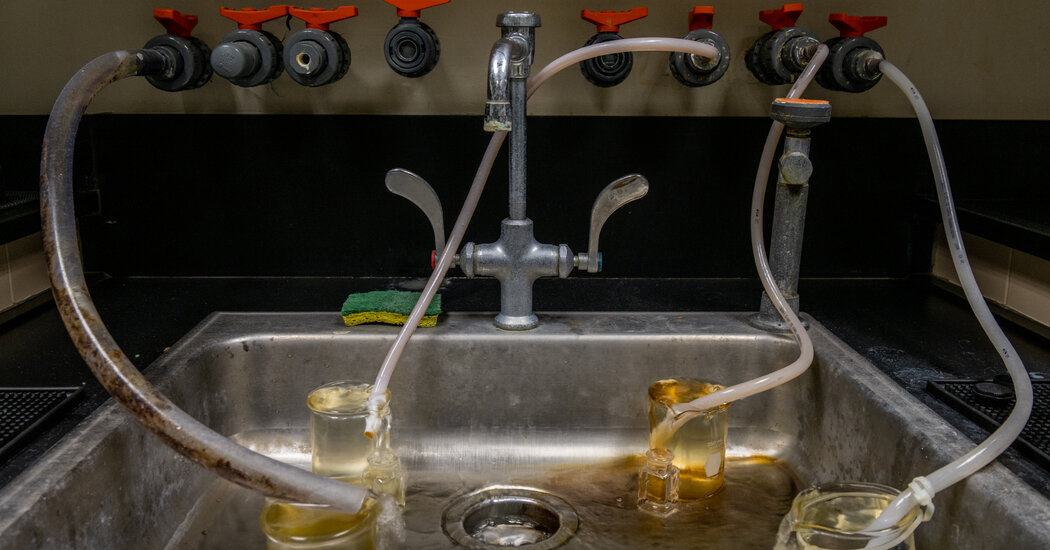The Environmental Protection Agency said Wednesday that it would uphold drinking water standards for two harmful “forever chemicals,” present in the tap water of millions of Americans. But it said it would delay deadlines to meet those standards and roll back limits on four other related chemicals.
Known as forever chemicals because of their virtually indestructible nature, PFAS are a class of thousands of chemicals used widely in everyday products like nonstick cookware, water-repellent clothing and stain-resistant carpets, as well as in firefighting foams.
Exposure to PFAS, or per- and polyfluoroalkyl substances, has been associated with metabolic disorders, decreased fertility in women, developmental delays in children and increased risk of some prostate, kidney and testicular cancers, according to the E.P.A.
President Joseph R. Biden Jr. had, for the first time, required water utilities to start bringing down levels of six types of PFAS chemicals to near zero. He set a particularly stringent limit of four parts per trillion for two of those chemicals, called PFOA and PFOS, which are most commonly found in drinking water systems.
The Trump administration said it would uphold the limits for those two types of PFAS, but would delay a deadline for water utilities to meet those limits by two years, to 2031.
The E.P.A. said it would rescind the limits for the other four chemicals.
“We are on a path to uphold the agency’s nationwide standards to protect Americans from PFOA and PFOS in their water,” Lee Zeldin, the E.P.A. administrator, said in a statement. “At the same time, we will work to provide common-sense flexibility in the form of additional time for compliance,” he said. “EPA will also continue to use its regulatory and enforcement tools to hold polluters accountable.”
The move to weaken some PFAS limits came after trade groups representing the chemicals industry, as well as water utilities, had challenged the Biden-era limits, saying they created an impossible standard that would cost municipal water agencies billions of dollars to meet.
The chemicals are so ubiquitous that they can be found in the blood of almost every person in the United States. Government studies of private wells and public water systems have detected PFAS chemicals in nearly half the tap water in the country.
In 2022, the E.P.A. found the chemicals could cause harm at levels “much lower than previously understood” and that almost no level of exposure is safe.
Under the Biden-era rules, water utilities were required to monitor their water supplies for PFAS chemicals. And they were required to notify the public, and work to bring contamination levels down, if levels exceeded set thresholds: four parts per trillion for PFOA and PFOS, and 10 parts per trillion for four others.
Those four chemicals include GenX, once thought to be a safer alternative to PFOA, but which has now been linked in animal studies to damage to the liver, kidneys and immune system, as well as to developmental problems and cancer. The others are PFHxS and PFNA, as well as PFBS, a mixture of the chemicals, which have also all been linked to adverse health effects.
The agency said it planned to begin a new rule-making process for the four chemicals in the fall, and to issue the new rule next spring.
The administration’s plans were first reported by The Washington Post.
Health and environmental advocates criticized the move.
“This is a clear victory for the trillion-dollar chemical industry, not public health,” said Emily Donovan, a co-founder of Clean Cape Fear, an environmental group that has been working to address GenX and PFAS contamination of the Cape Fear River in North Carolina.
“This current administration promised voters it would ‘Make America Healthy Again,’ but rescinding part of the PFAS drinking water standards does no such thing,” she said. “It’s disrespectful to PFAS contaminated communities who have suffered debilitating illnesses and devastating losses.”
Erik D. Olson, senior strategic director for health at Natural Resources Defense Council, said the E.P.A.’s plan offered “modest consolation.”
But he also said the agency’s effort to roll back drinking water standards violated a no-backsliding provision included in the Safe Drinking Water Act.
“The law is very clear that the E.P.A. can’t repeal or weaken the drinking water standard,” he said. “This action is not only harmful, it’s illegal.”
Industry groups suing the agency over the Biden-era PFAS rules — including the American Water Works Association, the American Chemistry Council and the National Association of Manufacturers — did not immediately provide comment.
But in a statement accompanying the E.P.A.’s announcement, Alan Roberson, executive director of the Association of State Drinking Water Administrators, said he supported the Trump administration’s approach. The association represents drinking water program administrators in 50 states.
Mr. Roberson said states and water systems had been “struggling with the time frames” under the Biden-era rules to test for PFAS and build the necessary filtration infrastructure to start ridding drinking water supplies of the chemicals.
The moves came just weeks after Mr. Zeldin announced a spate of measures to tackle PFAS contamination, including designating an official to lead the agency’s efforts on the chemicals.
The agency said it would also create guidelines for how much PFAS factories could release in their wastewater, and engage with Congress to come up with ways to hold polluters responsible.
Mr. Trump and the White House have also weighed in on the health harms of PFAS, albeit in a document outlining a strategy to rid the country of paper straws.
Maintaining the stringent limits for PFOA and PFOS was still expected to translate to a significant cost burden for water utilities. The E.P.A. had estimated that it would cost utilities about $1.5 billion annually to comply with the rule. Utilities had said that the costs could be twice that amount, and that the public would ultimately foot the bill in the form of increased water rates.
James L. Ferraro, an environmental attorney who represents several water utilities, said the Trump administration’s approach, while representing a compromise, was “not one utilities were necessarily hoping for.”
PFOA and PFOS, for which E.P.A. maintained strict limits, “are by far the most commonly detected, owing to their decades-long, widespread use” and cleaning them up “remains a serious challenge for many utilities,” he said.
Many environmental groups say that the costs of cleaning up PFAS should ultimately be borne by the manufacturers of the chemicals. They point to how chemical companies for decades hid evidence of the dangers of PFAS, according to lawsuits, industry documents and peer-reviewed studies.


